The Art of Living
The world-renowned Textile Museum will move to GW's Foggy Bottom Campus.
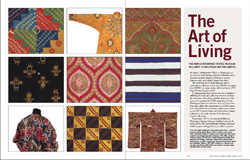
![]()
(From left to right) A detail from a Huari-style Peruvian tunic, c. 750-950, acquired by George Hewitt Myers in 1941; a detail of a man's caftan (back), Uzbekistan, Bukhara or Tashkent, second half of the 19th century; a detail of a tent hanging from India, Golconda, 1750-1850; a detail of a Peruvian mantle, circa 100 B.C.; a textile fragment from Turkey, Bursa dated the 16th century; a detail from a Navajo chief's blanket, Phase 1, North America, ca. 1850; a detail from a woman's robe (munisak), Central Asia, Uzbekistan, Bukhara, 1825-1850; a detail from a Peruvian tunic, Inca style, Late Horizon (1480-1534); and a detail of a furisode, Japan, Late Edo Period, mid-19th century
Where in Washington can you view the world's leading collection of Mamluk carpets alongside sumptuous Japanese silk kimonos, ancient Peruvian tunics, and colorful Central Asian ikats?
The world-renowned Textile Museum, with its extraordinary collection of more than 19,000 items dating from 3000 B.C. to current times, will be moving to GW's Foggy Bottom Campus in 2014.
A unique partnership between the two institutions will bring the museum's collection of textile art from the Near East, Asia, Africa, and the Americas to the soon-to-be-constructed, 35,000-square-foot, George Washington University Museum at G and 21st streets. Plans also call for the construction of a 20,000-square-foot, state-of-the-art conservation and resource center on the GW Virginia Science and Technology Campus dedicated to the study and care of the museum's historic collections.
Housed since 1925 in two adjacent buildings in Washington's historic Kalorama neighborhood, just off Embassy Row, The Textile Museum will enjoy increased exhibition space in Foggy Bottom, as well as expanded access to its collections as it integrates its activities into the far-reaching GW academic community.
A leading international center for the exhibition, study, collection, and preservation of the world's textiles, the museum is home to a vibrant mix of rugs, clothing, and other woven treasures, plus the 20,000-volume Arthur D. Jenkins Library of Textile Arts. Through its permanent and changing exhibits, scholarly publications, and wide array of lectures, workshops, and other educational programs, the museum reaches a global audience—with members in every state and 55 countries.
"We at George Washington University are honored and frankly thrilled that this unique cultural and scholarly resource will now grace and enrich our campus," GW President Steven Knapp told a standing-room-only audience at a July 26 press conference announcing the partnership. The collaboration, he said, will create significant opportunities for students, faculty, and scholars and "reaffirms the university's role as a vibrant center for cultural and artistic discovery and discourse."
At the announcement, President Knapp acknowledged the generosity of Albert H. Small, one of the nation's foremost collectors of historic documents, whose unparalleled collection of artifacts on the history of Washington, D.C.—which he donated to GW in February—will be another pillar of the future George Washington University Museum (see story in spring 2011 edition of GW Magazine).
The Textile Museum's rich history began more than a century ago, when founder George Hewitt Myers purchased an Oriental rug in the 1890s to decorate his dorm room at Yale, igniting his lifelong passion for collecting handmade textile art.
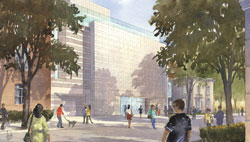
An artist's rendering shows a view of the to-be-constructed Textile Museum from 21st Street.
Concept Draft
From his earliest days as a collector through the establishment of the museum in 1925, Mr. Myers amassed an impressive collection of 275 rugs and 60 related textiles—from boldly colored Oriental carpets to some of the best preserved pre-Columbian pieces from South America. The collection multiplied over the decades into one of the most important of its kind. Highlights of Mr. Myers' holdings include classical silk textiles and carpets from the court workshops of the Safavid, Ottoman, and Mughal empires; early Islamic textiles; late antique textiles from Egypt; and archaeological textiles from Peru. His focus ultimately expanded to include widening the scope of knowledge about these objects—a mission that endures at The Textile Museum.
"George Hewitt Myers was a visionary and a connoisseur who set the aesthetic definition for beautiful textile art," says Bruce P. Baganz, president of the board of trustees of The Textile Museum. "We are an institution with a history based on achievements in art, scholarship, publication, education, and the promotion of cultural understanding. The Textile Museum is uniquely situated to integrate its activities broadly with academic disciplines."
Speaking at the July announcement, Mr. Baganz emphasized the strength and parallel missions of the two institutions: "This relationship ensures The Textile Museum's exciting future with increased access to its superb collection, enhanced scholarly activities, and continued focus on public programs, education, and exhibitions."
At the event, Ford W. Bell, president of the American Association of Museums, offered congratulations to both parties. "This is truly a unique partnership in the museum world…that joins two pillars of Washington's cultural and educational life," he said. "By combining resources, they increase their reach and impact and maximize their respective strengths. This partnership will undoubtedly enrich us all."
According to Provost Steven Lerman, the GW community will reap tremendous benefits from having a museum on campus. "We expect there to be close ties between The Textile Museum and George Washington University's academic programs, particularly in the areas of museum studies, museum education, anthropology, history, and the arts," he says.
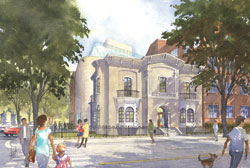
The historic Woodhull House at 21st and G streets will be renovated to host gallery and exhibition space.
Concept Draft
The museum will significantly enhance GW's academic life, he continues, creating "extraordinary exhibits for visitors while concurrently teaching our students about museum collections, operations, and finance. With its two anchors—a world-renowned collection of textiles and the Albert H. Small Washingtoniana collection—the GW Museum will provide a treasure trove of materials for study by faculty, students, and the entire Washington, D.C., community."
GW Executive Vice President and Treasurer Louis H. Katz says the GW Museum—which has been part of the university's campus plan since 2007—will "foster the study and appreciation of art, history, and culture" both within the university and throughout the global community. "Bringing together these world-class collections with GW's academic resources, technical expertise, and existing arts collections and activities provides many opportunities for scholarship, academic- and student-focused activities, and research-based programming reaching scholarly audiences and the broader public," he says.
During a recent visit to The Textile Museum, GW Magazine got a taste of its cornucopia of treasures—from a brilliantly colored 2,100-year-old pre-Columbian Paracas mantle from South America to a sensational array of carpets, articles of clothing, and quilts from China, India, Uzbekistan, the indigenous cultures of the Americas and the Islamic world. Ancient textiles created from wool, silk, cotton, linen, and even peacock feathers were showcased alongside contemporary sculptures by leading textile artists in the special exhibition "Green: The Color and the Cause."
"Mixing tradition with innovation is something we celebrate at The Textile Museum," says Maryclaire Ramsey, the museum's director. "Textiles are a universal art form that speaks to all cultures, people, and societies from around the globe and across centuries and time."
The museum's permanent collection is complemented by a variety of special exhibitions. Earlier this year, the museum drew rave reviews for its exhibit of Central Asian ikats—boldly colored garments and wall hangings in eye-catching designs that derive their name from the ancient binding technique used to create them.
The current exhibition, "Second Lives: The Age-Old Art of Recycling Textiles," on view through Jan. 8, 2012, showcases repurposed textiles drawn from the museum's permanent collection. Throughout history, textiles were considered so precious that threadbare fabrics were rarely discarded; they were simply recycled to create beautiful new textiles. The exhibition, spanning cultures and centuries, features items ranging from a vest fashioned from a Pacific Northwest coast Chilkat blanket to a rare sutra (religious text) cover made from a 15th-century Chinese rank badge.
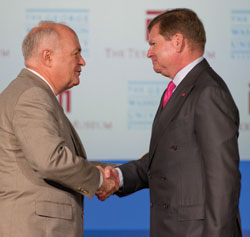
GW President Steven Knapp shakes hands with Bruce P. Baganz, president of the board of trustees of The Textile Museum, at the July 26 press conference announcing the partnership.
William Atkins
In October, the spotlight turned to Central African textiles with the opening of a new exhibition titled "Weaving Abstraction: Kuba Textiles and the Woven Art of Central Africa." The exhibition, which runs through Feb. 12, 2012, showcases some 150 textiles woven from palm fiber—from exquisite baskets to ceremonial skirts measuring more than 15 feet long. Accompanying the exhibition is a 218-page catalog presenting new research on Kuba textiles.
In some cases, the museum's special exhibitions spur the creation of new works of textile art. For the upcoming exhibition "Sourcing the Museum," which opens in March, renowned textile designer Jack Lenor Larsen invited 12 contemporary textile artists to explore the museum's permanent collections and create new works based on pieces that inspired them. The 12 new creations will be displayed in the exhibition alongside the historic textiles that sparked their imagination.
At times, the museum's treasures travel far beyond the borders of Washington, D.C. "Museums such as the Metropolitan Museum of Art in New York routinely borrow pieces from our collection for their exhibitions," Mr. Baganz says. "Currently, three pieces from our South American holdings are on view in "The Andean Tunic" exhibition at the Met, and our acclaimed ikat exhibition will be opening at the Seattle Art Museum in March 2012 and then traveling to the Museum of Fine Arts in Houston in 2014."
Like GW, The Textile Museum engages regularly with the international community at its doorstep. "We work very closely with the diplomatic community in Washington, which creates unique opportunities," Ms. Ramsey says. In 2009, the museum teamed up with the Embassy of Indonesia to offer a two-week special exhibition of Indonesian batiks from the collection of Ann Dunham, President Obama's late mother. Recently, the ambassador of the Democratic Republic of the Congo served as an honorary host at the opening reception for the exhibition on Kuba textiles, which hail from that region.
"We are currently working with the Embassy of Japan on an upcoming exhibition of imperial silks created by Kyoto's Tawaraya workshop," Ms. Ramsey adds, noting that the Tawarayas have been supplying the Japanese Imperial Household with fine silk garments and furnishings for more than 500 years. Hyoji Kitagawa, the 18th-generation head of the Tawaraya workshop, recently was designated a Living National Treasure. Mr. Kitagawa plans to travel to Washington for the exhibition, which coincides with the 100th anniversary of the cherry blossoms this spring.
Throughout the year, The Textile Museum engages with the general public through a wide range of educational programs—from lectures and workshops to gallery talks and family festivals featuring hands-on activities. An annual highlight for the children of Washington is the museum's partnership with D.C. Public Schools. "Our docents spend several months each year working with teachers and students in three D.C. schools to create a textile project, typically a quilt, and we unveil the final products during our Celebration of Textiles family festival the first weekend in June," Ms. Ramsey explains. "Some of their work is absolutely amazing."
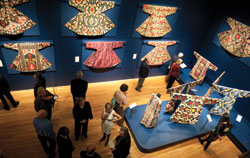
The Textile Museum's special exhibit, "Colors of the Oasis: Central Asian Ikats," will be traveling to art museums in Seattle and Houston.
Another popular Textile Museum offering is PM @ The TM, a series of after-hours social events at the museum aimed at young adults that Ms. Ramsey expects will "grow by leaps and bounds" at GW. The first Wednesday of each month, the museum presents its own version of "Antiques Roadshow" called Ask-A-Curator, Ask-A-Conservator. The ongoing program encourages members of the public to bring their textiles to the museum to learn about their history and significance, as well as to receive advice on how to best store and display the works. Since the 1970s, the museum has hosted Rug and Textile Appreciation Mornings on Saturdays, during which experts, collectors, and the curious come together to share examples and discuss wide-ranging topics.
The museum held its first on-campus program at the Jack Morton Auditorium on Oct. 14. Part of a three-day symposium exploring the cultural importance of textiles in Central Africa, the event welcomed a host of renowned scholars to GW. The following day, The Textile Museum held its annual ceremony for the George Hewitt Myers Award, which Mr. Baganz calls "the highest honor in the field of textile arts."
"It's a great way to bring people together to celebrate some of the brightest, highest achievers in the world of textile arts—from scholars and philanthropists to ethnographers and designers," he says.
According to Mr. Baganz, the museum's upcoming move to GW also will enable it to connect virtually with a larger portion of the textile arts universe. "Our audience is worldwide, and since many cannot travel to Washington in person to view our collections and participate in our programs, we hope to ultimately become the 'global information switchboard' for textile arts, an endeavor that has applications far beyond the museum itself," he says. "GW has the technological resources to accomplish this aspiration."
"This is an affiliation based on strength, and we eagerly anticipate many collaborative opportunities across widespread disciplines as we integrate The Textile Museum with the GW academic community," he concludes. "The future is limited only by our imagination."
